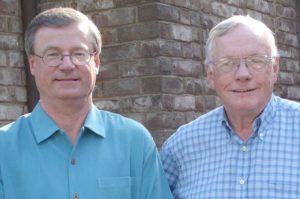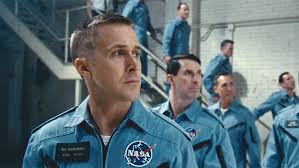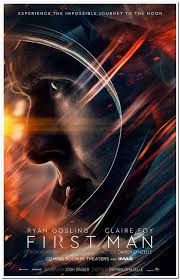Interview: James R. Hansen, Author of the Neil Armstrong Book “First Man”
Posted on October 28, 2018 at 4:27 pm

Where were you when you watched the moon landing?
I was on the floor in front of our television set, back in the day when television sets were these console units where the exterior was built into the TV. I was right in front of the TV set on the floor, in Fort Wayne, Indiana between my junior and senior year of high school. I was taking the college aptitude test that summer, working at a golf course mowing grass. I think I watched every minute. I think I was there probably from noon until midnight, so probably 12 straight hours of watching the coverage of Apollo.
So you grew up with the space program.
I was a second grader when Alan Shepherd flew the first space flight. We went down into the gym and took off our shoes and they had a big boxy TV right at the mid-court circle of the basketball court. That flight was just a sub-orbital flight that lasted maybe 15 minutes but I remember very clearly where I was on the floor. There was just something about the age and the era and the promotion of space exploration that grabbed a lot of people. I didn’t do a whole lot between the launches or between the missions but when it did happen I usually found my way to a TV set one way or the other.
One thing that will surprise people when they see the movie is that the space capsule is so small and vulnerable. Is that the way that Neil described it to you?
The vision of the director, Damien Chazelle, was to make the experience immersive for all of the movie viewers and to make it very visceral as well and so I think as a result there’s an emphasis on the sound. If you recall just the shutting of the hatches and everything, it’s almost like they’re being entombed in these things. At one point I went to the museum with Neil where the Gemini VIII spacecraft was still located. The Gemini in particular is just for two men. It’s just such a small space. The Apollo was rather roomy in comparison. I don’t think I did in my book as much as what Damien does in the film to communicate the almost claustrophobic aspects of being in these capsules and so I think the audience will experience this in a way that is in a lot of ways different than it’s been portrayed in earlier movies where you don’t experience the sounds and the vibrations. Damien went out of his way to try to put the viewer in to see it through Neil’s eyes, to feel it in a very direct kind of way, and I think that’s one of the really incredible things about the film.
What made Neil the right guy for that job?
In terms of his general training and experience for astronaut selection, here is a guy that had flown as a test pilot virtually every advanced experimental flying machine that the country was testing between 1956 and the time he became an astronaut in 1962. He was in fact in the second group of astronauts, which was an incredible group with James Lovell and John Young and Frank Borman and Ed White. Neil was the only one who had any experience for flying a rocket-powered airplane, the X-15, which is shown in the very first scene of the film. In terms of him becoming the commander of Apollo 11, one thing I try to do in a lot of my lectures is make clear that there was nothing preordained about him being the one selected. The approach to putting teams together the key was choosing good commanders and he had a feeling deep down that any of the commanders could have done any of the missions.
So Neil always made sure people understood that his opportunity to command Apollo 11 was really a matter of contingent circumstances. He was in the right place in terms of the order of the rotation. Still, he was really an outstanding person to end up doing it — I don’t think there’s any question about that. He had had the major problem with the Gemini VIII flight. There was some second-guessing about it, but in the end everybody felt like he and Dave Scott had handled that emergency extremely well under unbelievable pressure. So I think all of that’s relevant. On one hand it is important to make clear that he was really well trained and a good person to do this particular mission, on the other hand there were other good men as well that probably could have done it as well as he and I think the other commanders could have done the missions.
What is it that makes someone able to stay calm under that kind of pressure?
One thing that the movie can’t show that the book can and does is that in the movie we only see Neil in three flights, in three flying machines; he’s in the X-15, he’s in the Gemini VIII and he’s in Apollo. The guy made hundreds of flights in hundreds of different machines and he’d been flying since he was 16 years old, so he had experienced so many different flying machines and experiences in airplanes and there have been tough challenging moments in a lot of those flights. He flew 78 combat missions over North Korea and had half of his wing clipped off in one of them and he had to eject from the plane.
If you fly that many times, you are going to run into problems and things that are not working quite right. So the one thing that you can’t communicate in the film is that this guy has been in these things hundreds and hundreds of times. They’re engineers and test pilots in the plane so they really know the systems as well so that is an element that sort of explains their confidence in what they’re doing.
He was calm, but we know from the telemetry data that Neil’s heart rate was one of the highest if not the highest heart rates in almost all those flights and I talked to Neil about it. Neil’s own take on it was that if you really see when his heart rate peaked, it was always when he was in anticipation of some high-performance moment that he was going to have to execute. So really his take was that it wasn’t a representation of stress or anxiety about the flaw but just the body and the mind together getting ready for something that was going to have to be done out of the ordinary. He does have other instances of high heart rates too when he was over at Little West Crater during his lunar EVA. He had to get over to Little West Crater and get back to the lunar module pretty quickly because that wasn’t really a scheduled thing for him to do and there wasn’t much time and mission control was kind of nagging him to get back to the lunar module. When he was over at the crater his heart rate was over 180. Again it’s a question of how you interpret that, but I’ve always been a little bit reluctant to describe him as this cold, calm, collected person what nothing unnerves when a man is running such a high heart rate at the same time.
The movie focuses quite a bit on the way that Neil dealt with the death of his daughter. What did he tell you about it?
Typically of Neil, it was hard to get him to talk about it. I probably got him to talk about it more than anybody else ever had. As the movie makes it clear, he didn’t even talk to Janet about it and Janet told me the same thing. He just would not talk about it and Janet needed him to talk about it. She needed a husband that was comforting and supporting and she needed to be able to express her own grief. That’s one of the really sad things in their relationship and I think the movie captures that in some beautiful ways, especially that last scene. I got most of my information about the effect of the death on Neil from Neil’s sister June and from Janet because they observed it first-hand. June, who really loves her brother, was very understanding and she told me stories about in the aftermath of the death, stories that reinforced for her what a special love Neil had for that little girl and how it affected him not only in the immediate aftermath of the death but in her eyes how he never got over it.
The line when he responds to a question in his interview for the astronaut program in the movie comes from my book. I asked, “Did this affect your flying in any way?” and he said, “I think it would be unreasonable to assume that it would have no effect.” That’s just classic Armstrong speak. It’s an answer but it’s not terribly direct.
He didn’t really bring her baby bracelet to the moon and leave it there, did he?
There’s certainly no evidence that he did. The thing is there’s also no complete evidence that he didn’t. We don’t know what he took to the lunar surface because the manifest of the contents of his PPK (the personal property kit) where they took personal items has never been seen. Neil apparently had it. I asked him if I could look at it and he was going to try to find it and never found it and the boys don’t have it and Purdue University archives doesn’t have it so we don’t know where it is and even if we do find the manifest was what he took/the personal items that he took if something was really, really private he wouldn’t have necessarily even listed it.
Another part of this is that the visit over to the Little West Crater was not scheduled. It was not part of the mission plan. He just decided to go over and do that himself and what he did over there we really don’t know for sure because the TV Camera wasn’t on him at that point in time so it was a completely private moment. Sometimes the power of poetry prevails over the uncertainty of fact. I’m okay with it because there’s just enough degree of uncertainty about this that it’s not necessarily counterfactual, we just don’t know for sure.


